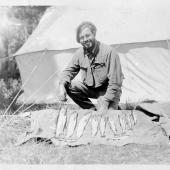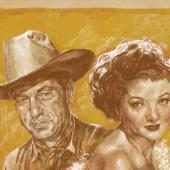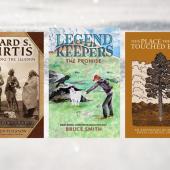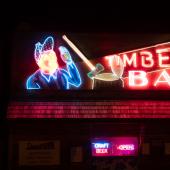The Incredible Holt Heritage Museum
photos by Bryony Schwan
Located along Highway 12 and directly across the highway from the entrance to Traveler’s Rest State Park in Lolo, Montana, is the Holt Heritage Museum.
Long before archeologists positively identified the site of Lewis and Clark’s most famous camping site, Bill and Ramona Holt owned the land for their H Bar R Ranch, which specialized in longhorn cattle. Upon learning the significance of the site, the Holts actively worked with the state by donating and/or selling land, visitor center facilities, and historical artifacts to ensure the site’s preservation and public significance.

The flyer for the Holt Heritage Museum beckons visitors to “Enjoy a Lifetime Collection of Rodeo and Indian Artifacts” in a museum dedicated to “Cowboys and Indians — Rodeos and Pow Wows.” True, much like the Traveler’s Rest Visitor Center, the Holt Heritage Museum offers an incredible array of valuable western and Indian artworks and artifacts. But that’s really only the beginning. What sets the Holt Heritage Museum apart from any other museum is its stories — rich, detailed, personal stories that bring each piece of art and each historical item alive with meaning and context. Holt Museum visitors do not wander about on their own, but rather they are personally guided by museum owners, Bill and Ramona Holt.





It may seem an oxymoron to call a couple “Renaissance Ranchers;” yet that term best describes the Holts. Their interests, talents, and life experiences span multiple disciplines, from the sciences to the arts to cattle breeding. As a veterinarian, Bill volunteered as an official for the Alaska Iditarod dog sled race. As the first woman west of the Mississippi River to receive a degree in ichthyology (study of fish), Ramona started her own hatchery business. He participated in the first ever National Intercollegiate Championship Rodeo. She was a champion barrel racer. He taught himself the auctioneers’ chant and then used that skill to become a Rodeo Finals announcer as well as a member of the Montana Rodeo Hall & Wall of Fame and the Legends of Rodeo. She managed the auctions and rodeos where Bill announced. They raised and bred longhorn cattle in the United States, Canada, and were the first to introduce them into Australia. They owned and operated a tourist resort, which included a replica of an old west town. They started a successful steak house restaurant. They are both pilots. Both art aficionados, they have been instrumental in getting many western artists recognized in the art world. Ramona is a descendent of the Navajo tribe.

The breadth and depth of the Holt’s wide ranging interests and vast rodeo experiences are at the heart of their Heritage Museum. Their deep love of the western lifestyle and Montana’s cowboy and Indian cultures along with their scientific background clearly informs the museum, both in the selection of the items and the way in which they are displayed. They personally acquired each piece, lovingly restored many from long neglect, numbered, cataloged, and now artfully showcase them.
Rather than searching out specific novelties, they let their interests be known within their vast personal network, and let things find their way to their door. Every museum piece carries its story of origin and how the Holts came to possess it, such as that of the rare and invaluable Blackfeet Indian pollywog shirt worn only by medicine men or warriors (pollywogs were revered because of their ability to changes forms and become frogs). It was found in excellent condition in a Blackfeet family’s old trunk. Its owner exchanged it for the title to the Holt’s Mercedes car.





Hanging above the pollywog shirt is an equally unique shirt covered with shells and traditionally used by young Blackfeet girls coming of age. Pacific Northwest Coastal Indians used tiny dentalium shells of the scaphopod mollusks as international trade items (“wampum”) with Plains Indians. The Blackfeet painstakingly sorted the shells, strung them together, and sewed them to trade cloth or fine leather. Each shirt took thousands of shells to complete. The dentalium shells were so popular with the Indians across North America, that they were almost driven to extinction through their harvest.
When asked about a hanging noose casually draped over a doorway, Ramona responds that it was the rope used in Montana’s last hanging execution, which happened in Missoula County on September 11, 1943. Missoula County Sheriff John Moe was later transporting a prisoner to the Canadian border. On his return, he stopped in Shelby where he helped the Toole County sheriff pull a car out of the snow with a rope. Yup, Sheriff Moe recognized the rope from the hanging and asked if he could have it. He understood the rope’s historic significance and donated it to his friends, the Holt’s, for their collection.





Cases abound with all manner of 1800’s tools, spurs, knifes, guns, belt buckles, and jewelry. Book shelves are lined with beautifully handcrafted leather cowboy boots worn by some of Hollywood’s most famous silver screen cowboys and cowgirls such as Ronald Reagan, Elizabeth Taylor, Roy Rogers and Dale Evans, Gene Autry, Buck Owens, Dolly Parton, James Arness, Cisco Kid, Tom Selleck and others. Signed photos of some of rodeo’s most famous riders, clowns, and Hall of Famers line the walls of the hardcore rodeo room. Original sheepherder, chuck, and transport wagons and carriages look sparking new and are parked both inside and outside of museum buildings.
Of special note is the full 33-piece collection of Bob Scriver’s essay in bronze, The Honest Try. These intricately detailed sculptures are dedicated to “all those free spirits who have, by their courage, fair play, and honest efforts, created the uniquely Western American sport call RODEO.” Scriver’s focus on the actions, muscles and concentrations of the riders and animals viscerally captures the intensity of each moment: the bronc rider, the bull rider, the rodeo entry queen, the barrel racer, and the list goes on.




Dunrovin, a small guest ranch along the Bitterroot River specializing in personal service and quality horseback riding, has been engaged with the Holt Heritage Museum and fascinated by the life stories of its creators. In the coming months, Dunrovin will work with Ramona and Bill to bring their stories alive online via the magic of our web cameras at www.DaysAtDunrovin.com and to record them for posterity. They, and we, hope to keep the western culture alive and connect people with the stories, photos, artifacts, and voices of those who have played a role in passing it on to us. Prominent among those people are Bill and Ramona Holt.
















Leave a Comment Here